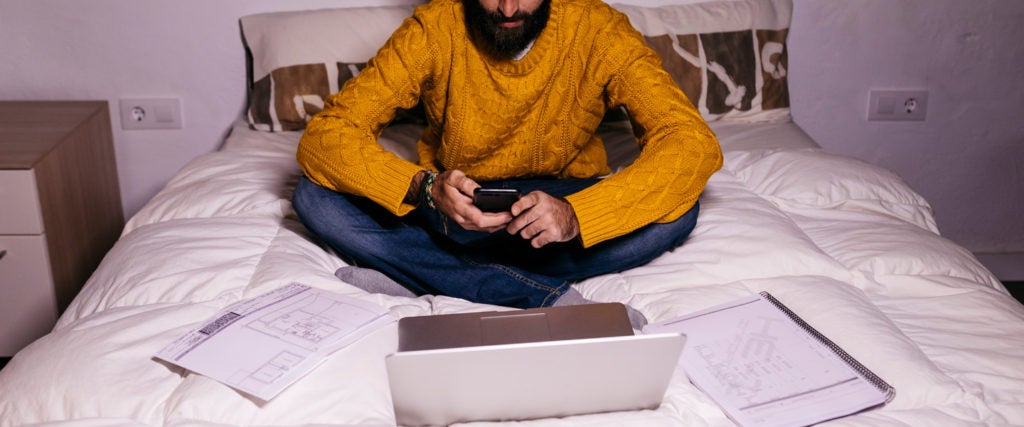Before practices and games in professional sports, reporters typically talk to the team’s coach in informal little huddles. It’s a pile of dudes surrounding a taller, crankier dude, firing off questions like, “Do you think so and so is gonna start shooting three pointers?” and “How did the defense look to you tonight?”
Seeing as how we’re not allowed to be in huddles right now, this can’t happen like it normally would. (The NBA might be coming back next week, but it won’t involve crowds or beat reporters.) And so, like much of the work in pandemic times, the scrum has moved over to Zoom. It was there that I saw a beautiful sight: Erik Gundersen, a freelance reporter, asking Portland Trail Blazers coach Terry Stotts about Jusuf Nurkic’s three-point shooting while visibly laying in bed.
Stotts, a former pro athlete and preternatural Type-A, was indignant. “Erik, are you in bed?” he asked.
“Yes, I am. I’m relaxed.”
“You could have gone to a desk or something.”
“I’m on my phone, Terry. I’m relaxed. Listen, I’m working from home.”
“It’s 12:45 in the afternoon! Get out of bed!”
Here's Stotts roasting @Erik_Gundersen https://t.co/zptKQ0kzIt pic.twitter.com/hxXl9UVTWZ
— Dylan Mickanen (@DylanMickanen) July 1, 2020
In fairness to Gundersen, he WAS on vacation — sort of. He and his wife were still working remotely, but they’d migrated from their normal base of operation in a small apartment in Portland, to a family member’s cabin in Sunriver, Oregon with his wife’s cousin and their newborn baby. Work was still there, “but the accoutrement of work was different,” Gundersen tells me. As a freelancer, he is used to working from home, but having his wife in the space all day is new for him. “We were so stoked to be invited to leave our apartment,” he says. “Because even if we have to work a little bit, we’re literally in a different space, and that helps.”
Most days, Gundersen and his wife have three places in their apartment where they can toil professionally: their kitchen table, their couch, and yes, their bed. Meanwhile, he insists that the bed Stotts called him out on for working from wasn’t even the bed he was sleeping in at the cabin; it was a designated “work bed” in another room of the house. But he admits that even when he isn’t on vacation, he indulges in the simple pleasures of working from his sleep space “at least twice a week.”
“The state of the world, specifically this country, is pretty shitty,” he reasons. And so, when despair grips, “It’s like, you know, ‘Maybe I’ll just work from bed today. Fuck it.’ Work’s gotta get done, gotta get my posts up, but sometimes you don’t wanna sit on the chair.”
Kimberly Hutchison, an associate professor of neurology and sleep medicine at Oregon Health & Science University, says quarantine has had a profound effect on our bedtime habits. On one hand, if you typically spent a long time getting ready for work or had an onerous commute, you now have more time to sleep, allowing workers to follow their natural circadian rhythms as opposed to the rigid schedule society prescribes in defiance of evolution and human nature. But, she notes, “The line between work and home life is getting blurred. People are potentially not able to separate some of the work they’re doing and the mind shift that goes with that, because they’re doing it all under one roof.”
As such, those who are restricted to one building will often find themselves doing work in the most comfortable setting. And there’s (hopefully) no more comfortable setting than your bed — even if it’s far from the best place to post up when on the clock.
“Sleep professionals have never recommended working from bed, whether you’re stuck at home due to COVID, or you’re doing catch-up from the day’s activity in the evening,” Hutchinson explains. “In general, the best sleep hygiene is to keep the bed for sleep and sex only. You want to create a sleep sanctuary where you can wind down and get ready for bed. Then your brain gets in the habit of going to sleep once you get into bed and you follow a certain routine at night. If you disrupt that association by doing work, it can lead to sleep problems. It can make it difficult to fall asleep, difficult to stay asleep and difficult to quiet your mind down as you get ready for bed.”
Sarah Austin, a therapist who works with kids in the foster-care system with behavioral issues, has found herself in an alien working environment during quarantine, going from working “100 percent in the community to working 100 percent in the house.” “A lot of my job is crisis intervention,” she says, “and a lot of my skill set is around being present with someone when they’re going through a crisis. When I removed the ability to be physically present with them, it felt like my effectiveness to manage the crisis was a lot less. I had to learn a whole new skill set of how to be present with someone over the phone or a video.”
In this new realm, Austin says she’s been working from bed for at least a chunk of time every day, or during “anything I can turn off my webcam for.” “I think, partially, I do it because it seems like one benefit of working from home, where most of it has been downsides,” she tells me. “To be in your very comfortable bed with your weighted blanket and your comfy pillows is a plus.”
That said, Austin’s sleep was a little janky at the beginning of quarantine, and she thinks her bed office was a contributing factor. “I needed to establish some sort of differentiation between work and rest,” she says. “I’ve now gotten into a routine that’s really helped. But it probably took two and a half months.”
Vanessa Postil worked from bed for several years before quarantine started. As the customer service manager for a small company in Seattle, she says the flexibility of working from home had previously given her time to pursue her outside interests. But with everything shut down, the privilege has lost some of its luster. In fact, even before quarantine, she was thinking about leaving home more often to work from a coffee shop, a plan that’s obviously been scuttled by the pandemic.
Today, though, her reasons for working from bed are as much about space (or a lack thereof) as anything else, as her 10-year-old daughter is always at home with her. “My bedroom seems to be the one space where I can close the door and be like, ‘I AM WORKING,’” she explains. “I used to like it. I used to be like, ‘I get to work from my bed!’ But I’ve learned that I don’t work as efficiently from my bed.”
If you’re also stuck working from your bedroom due to space/privacy constraints, Hutchison recommends trying to construct a workspace outside of your bed, sitting on a chair, and using whatever you have — be it a dresser or a bedside table — for your computer. She similarly suggests looking out of a window, away from your bed, so your brain can disassociate with the idea that you’re still in your bedroom.
“It’s really important to create a unique space that you can dedicate to work, and a unique space that you can dedicate to sleep,” she explains. “By doing so, your brain gets in the habit of working in the work space, and sleeping in the sleep space. Again, when you blur that line, it becomes more difficult to relax your mind at night and separate from your work.”
Even Hutchison admits, though, that the terror of bed work and the miserable sleep habits it encourages are always lurking. “My son was doing remote high school when COVID first started,” she tells me. “Teenagers have a tendency to stay up late and sleep in late. He would just wake up, open his laptop in bed and join his class. As soon as I figured out what he was doing, I was right up there, like, ‘Get that computer out of your bed, and come down and sit at your desk.’ ‘But mom,’ he’d say to me, ‘over half the people in the class are in their beds.’ I’d be sure to remind him, ‘Unfortunately, your mom is a sleep doctor.’”

